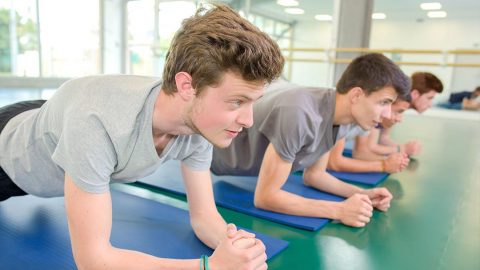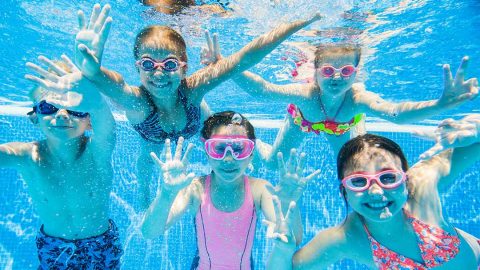By Coach Genevieve and Coach Lane, Greenwood Tiger Shark Coaches
Every swimmer knows how hard it is to be out of the water for this long. For most of us, it’s been months since the last time we jumped in a pool. We’re craving the opportunity to get back to doing what we love every day and yet most of us are probably a little nervous about what kind of shape we will be in when we get back.
Fortunately, the one activity that has been keeping most swimmers in shape is something that can really make a positive impact on their swimming. That’s right, I’m talking about dryland. Dryland can take many forms and different coaches have different methods for implementing it, but it is the best way to supplement a swimmer’s training inside the water with exercises done out of the water.
From a coach’s perspective, there are five main reasons that swimmers do dryland:
-
Increases coordination and body awareness to improve stroke technique
It’s a running joke among swimmers that we swim because we are uncoordinated and can’t do anything else. Whether that is true for you or not, doing dryland exercises will help you hone in on your strokes. As swimmers get older, learning about technique becomes more complex. A good dryland program includes a lot of repetitive motions to give swimmers more awareness over their movement and to give their muscles the feel they need to complete the more precise motions that come with technique growth.
-
Builds strength and endurance, specific to motions done as part of a stroke
Strength-building is the benefit that swimmers most commonly associate with dryland. It is easy to think that bigger, stronger muscles equal faster swimming, but it is not quite that
 simple. Let us take butterfly, the stroke in which everyone can see and feel the need for a little extra strength, as an example. In butterfly, a lot of swimmers have a hard time getting their arms out of the water and back around to the front, especially when they get tired. In that part of the stroke, you rely heavily on your triceps to be able to push your arms out behind you, and then it takes a combination of different muscles in your shoulder to get your arms around before they enter back in. Knowing that it is easier to see how a tricep extension exercise followed by some slow, small arm circles can translate directly into improving a swimmer’s butterfly.
simple. Let us take butterfly, the stroke in which everyone can see and feel the need for a little extra strength, as an example. In butterfly, a lot of swimmers have a hard time getting their arms out of the water and back around to the front, especially when they get tired. In that part of the stroke, you rely heavily on your triceps to be able to push your arms out behind you, and then it takes a combination of different muscles in your shoulder to get your arms around before they enter back in. Knowing that it is easier to see how a tricep extension exercise followed by some slow, small arm circles can translate directly into improving a swimmer’s butterfly. -
Develops a stronger core to give swimmers more control
If you are a swimmer, you probably have noticed that dryland can often involve a lot of core-centric activities, and they can certainly make your ab muscles burn. The reason for such a large focus on core starts with the importance of keeping your body in a straight line, or “streamlined” when swimming. No one would object that a torpedo travels a lot faster through the water than a pool noodle, which illustrates why body position is so crucial to swimming success. Having a stronger core that can keep your body line straight even as you grow fatigued gives you a lot more control over your body and can help you maintain the speed you need to finish out a race strong.
-
Prevents injuries
Injury is our least favorite part of the sport, and it is something that just about every swimmer, unfortunately, has experience with to some extent. While there are, of course, exercises that can help you rehab after an injury, dryland can also play a huge part in preventing injuries before they ever happen. One way that happens is ensuring that all strength-building exercises are done with the correct technique so that swimmers don’t inadvertently hurt themselves while trying to get stronger. There are also areas of the body like the shoulders where swimmers tend to be more vulnerable to injury, and using dryland as a way to increase strength and flexibility in those areas can significantly reduce your injury risk as well.
-
It’s fun!

Last but certainly not least, dryland is a way to bring an element of fun to swimming. Swimmers can all relate to getting caught up in the monotony of staring at the black line at the bottom while going up and down the lane for countless laps in a row. Using dryland as another training avenue is a great way to keep things fresh and fun for swimmers and help keep the love of the sport alive and well for everyone.
At GTS, we implement a dryland program that combines all of these elements to offer what we feel is a great, well-rounded experience for our swimmers. We feel it is important to make sure our swimmers have fun while also working towards new levels of success. To us, it is vital that our swimmers learn how to train well and understand why we implement the things that we do to create the best environment for growth and fun possible.
Try this fun workout at home with your family!
Deck of Cards Dryland Workout:
Option 1: Use a physical deck of cards
Each suit corresponds to an exercise
Pull one card at a time and do the number on the card of that type of exercise. For example, Spades are pushups, so a seven of Spades would mean you do seven pushups.
All face cards and Aces count as 10.
Exercises:
Spades – Pushups
Clubs – Crunches x two
Diamonds – Slow Squats x two
Hearts – Burpees (with pushup)
*For Clubs and Diamonds, multiply the number on the card by two
Option 2: Download an app called “Sweat Deck”
The sweat deck app is already set up this way, so all you need to do is download it and start
Keep smiling, laughing, and working out.
Coach Lane and Coach Genevieve
 Genevieve McNally
Genevieve McNally
Greenwood Tiger Sharks Head Coach
Genevieve is a long-time swimming and sports enthusiast. She has been the Head Coach of the Greenwood Tiger Sharks for the past two years, has been with the team for three years and part of the club for over 15 years. Genevieve swam for multiple club teams across the front range and swam at the University of Denver, alongside her four siblings. While at the University of Denver, she received her MBA with a concentration in Socio-Cultural Brand Management and has also earned her Lean Six Sigma Black Belt certification. Genevieve has a unique background in youth athlete development, due to her time in sports marketing, assisting in representing professional athletes. She possesses an understanding of what it takes to be an athlete and the intricacies of the mental and physical capacity it takes to accomplish one’s goals. Genevieve has a passion for fluid communication and helping others achieve their goals. Her hobbies include traveling, hiking, paddle boarding and swimming.
 Lane Bretschneider
Lane Bretschneider
Greenwood Tiger Sharks Assistant Head Coach
Lane has been in swim coaching since 2017. He got his start with Foothills Swim Team as an Age Group coach and has worked with all ages and ability levels since. He received a scholarship to attend and swim for the University of Denver and was a three year member of the Division 1 team. Lane has taught and still currently teaches competitive swim lessons at SwimLabs in Littleton, using cameras and other technology to break down stroke technique and help swimmers improve. He spends his free time enjoying live music, playing and watching sports and exploring the outdoors.
